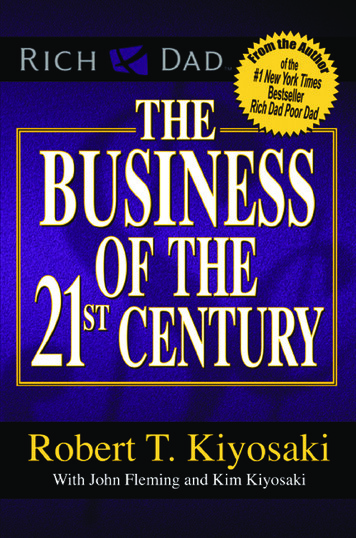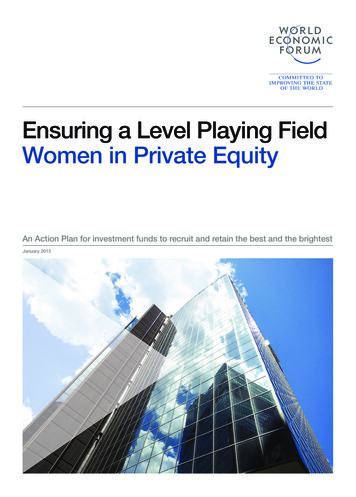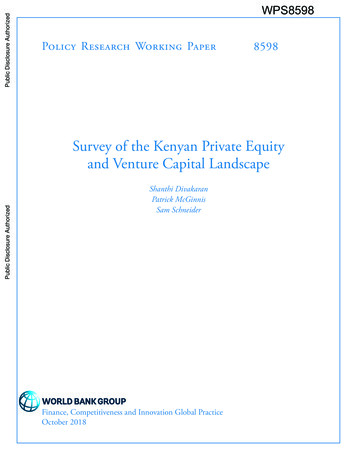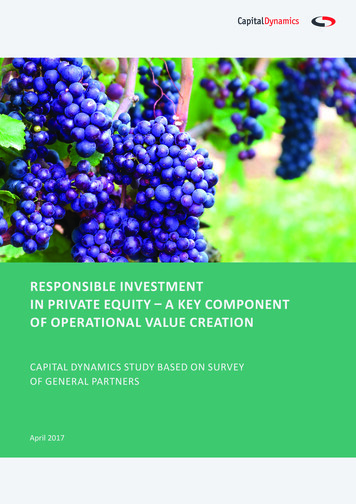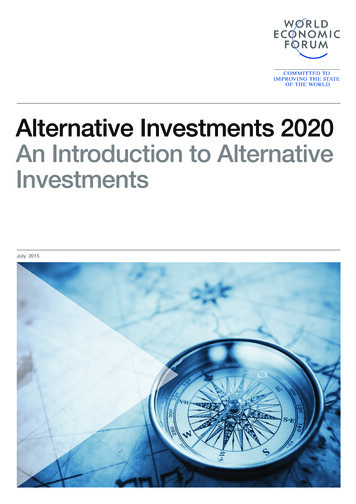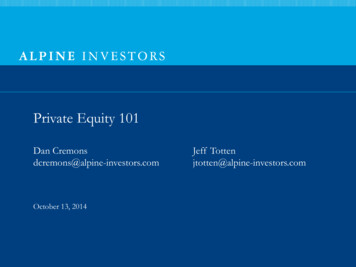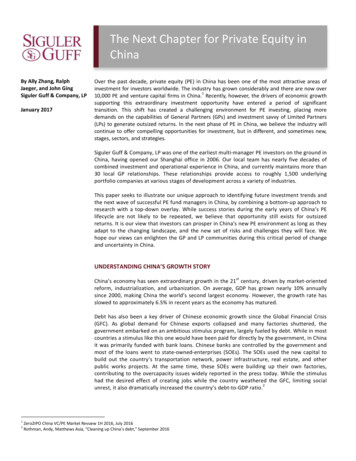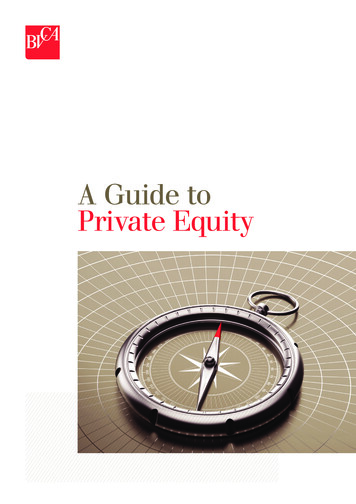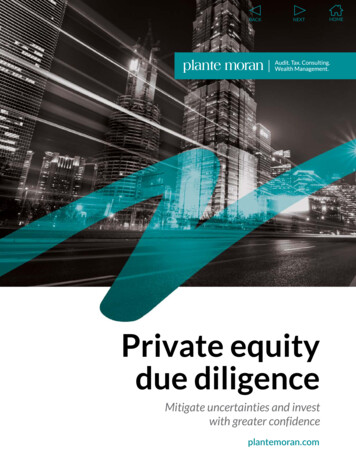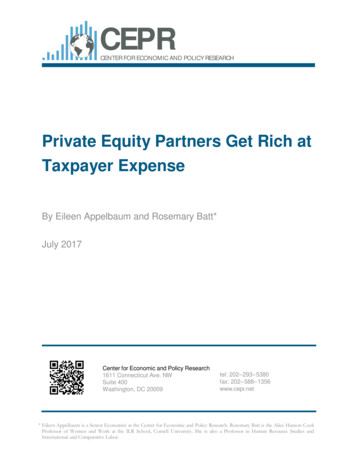
Transcription
CEPRCENTER FOR ECONOMIC AND POLICY RESEARCHPrivate Equity Partners Get Rich atTaxpayer ExpenseBy Eileen Appelbaum and Rosemary Batt*July 2017Center for Economic and Policy Research1611 Connecticut Ave. NWSuite 400Washington, DC 20009tel: 202–293–5380fax: 202–588–1356www.cepr.net* Eileen Appelbaum is a Senior Economist at the Center for Economic and Policy Research. Rosemary Batt is the Alice Hanson CookProfessor of Women and Work at the ILR School, Cornell University. She is also a Professor in Human Resource Studies andInternational and Comparative Labor.
ContentsIntroduction . 1Excessive Use of Debt . 2Tax Arbitrage . 3Pass Through Entities . 4Carried Interest Loophole . 5Management Fee Waivers . 7Management Services Agreements (Dividends Disguised as Monitoring Fees) . 9Exception to the Publicly Traded Partnership Rule . 12Conclusion . 13References. 14AcknowledgementsThis issue brief has benefited from discussions of private equity tax issues over the years with GreggPolsky. It summarizes work previously published by Appelbaum and Batt: Private Equity at Work: WhenWall Street Manages Main Street (2014) and “Fees, Fees and More Fees: How Private Equity Abuses ItsLimited Partners and U.S. Taxpayers” (2016).
“Private equity is essentially a giant tax gimmick with an acquisition attached. Funds employ a lotof tax talent.”Lee A. Sheppard, Tax Notes1IntroductionAs the Trump administration and the Republican controlled Congress prepared in June to turn theirattention to tax reform, they made clear their intention to develop their proposed revision of the U.S.tax code in secret. The plan, apparently, is to remake the tax system behind closed doors in meetingsthat include only top Republican Congressional leaders, excluding most Republicans, all Democrats,and the American public from the deliberations. Trump’s top economic advisor, former GoldmanSachs executive Gary Cohn, is on record saying, “We don’t want to be negotiating the tax bill on thefloor [of Congress].” 2In April 2017, the administration put out a one-pager that signaled what its tax proposals will include.Billed as tax reform, the document instead proposed massive tax cuts for business that will benefitTrump, his family, and his wealthy friends.3 The tax system already serves to enrich the wealthy and,as we learned from the Republican health care plan, more tax cuts for the rich and richer will come atthe expense of programs and services that middle and working class families need. According to theCongressional Budget Office (CBO), the Senate health care plan put forth by the Republicans wouldprovide 541 billion over 10 years in tax breaks for the wealthy and another 210 billion in otherreductions to the Treasury while reducing federal payments for Medicaid — a program that covershigh cost care for preemies, pays for nursing home care for the elderly, gives the poor access to healthinsurance, and provides services to disabled children and adults that enable them to participate inschool, work and their communities. 4 This tax “reform” can be expected to produce more of thesame.Private equity millionaires are among those who benefit most from the current tax system and whomay have the most to gain from some of the massive tax cuts outlined in Trump’s tax plan. In thisissue brief we examine the ways in which the current tax code benefits private equity firm partners.True tax reform would seek to make the tax code fairer and would redress the unfair advantagesenjoyed by this, and other, special interest groups.1234Lee (2015).Associated Press (2017).Appelbaum (2017).Golshan (2017).Private Equity Partners Get Rich at Taxpayer Expense1
Private equity gains an unfair advantage under the current tax system in several ways that are largelyunavailable to other businesses. Included in this briefing paper are the most important ways in whichprivate equity reduces its tax contributions. Excessive use of debtTax arbitragePass through entitiesCarried interest loopholeManagement fee waiversManagement Services Agreements (monitoring fees)Exception to publicly traded partnership ruleExcessive Use of DebtLeverage — the use of debt financing — is an important source of private equity earnings, due in partto the favorable treatment of debt in the tax code. A company’s interest payments on its debt are taxdeductible, thus reducing its tax liabilities. The tax benefits of debt encourage companies to employinefficiently high debt levels and to engage in tax arbitrage to reduce tax payments. Private equity firmstypically purchase companies via leveraged buyouts (LBOs) and make those companies private so thatthey are not subject to the scrutiny of outside investors or the financial reporting pressures andoversight by the Securities and Exchange Commission (SEC) that publicly traded companies face.The tax advantages of debt, of course, hold for any company — not just companies owned by privateequity. But private equity-owned companies carry much higher debt loads than publicly tradedcompanies — often two to three times the level. Private equity’s high use of leverage is unrelated tothe factors (such as size, R&D intensity) that typically explain the capital structure of publicly tradedcompanies. High leverage is at the heart of the private equity business model because debt multipliesreturns. Low interest rates and the availability of financing facilitate private equity’s use of a highlyleveraged capital structure when it acquires portfolio companies.5 The average leverage ratio in PEowned companies during the 2005–2007 boom was 75 percent debt. In contrast, the capital structureof a publicly traded company at that time was 75 percent equity. 6 Thus, PE-owned companies receivea considerably greater tax benefit than other companies from the use of leverage. In addition, taxsavings from the increase in debt can offset the interest payments on the debt.56Axelson, Jenkinson, Strömberg, and Weisbach (2008).Chakraborty, Weisbach, and Zhou (2009).Private Equity Partners Get Rich at Taxpayer Expense2
It is the portfolio company, not the PE firm nor the PE fund that acquired it, that must repay the debtits private equity owners used to acquire it. Thus the increased risk of bankruptcy inherent in theexcessive use of debt falls on the portfolio company, its employees, and its creditors. If, despite itsdebt burden, the company is successful, the high use of debt magnifies the returns to private equity.Leverage benefits the PE owners of a portfolio company in a second way as well. The reduction intaxes from the higher interest deductions associated with more debt increases the PE portfoliocompany’s enterprise value. Lower taxes due to increased leverage may account for 10 to 20 percentof the company’s value. 7 Thus, the enterprise value of the company, and the gain to its private equityowners, is increased by excessive use of leverage without a corresponding increase in economic wealth.These increased earnings for private equity investors represent a net loss for the tax-paying public,which is asked to pay higher taxes or face cutbacks in services as a result. In the case of leveragedbuyouts of publicly traded companies, the debt-to-equity ratio generally rises substantially. Publiclytraded companies are subject to greater financial reporting pressures and oversight by the Securitiesand Exchange Commission (SEC). The use of debt increases when these companies are taken privateand are no longer subject to SEC regulations and scrutiny by outside investors.President Trump indicated in his April tax policy outline that he wants to limit or eliminate the taxdeductibility of business interest payments. This is a welcome development and would be an effectivedeterrent to the use of debt as a tax strategy. However, the private equity industry and other WallStreet players are lobbying against it — and they have powerful influence in Washington via theircontributions to the Trump campaign and the presence of PE partners in top posts in the Trumpadministration — including Wilbur Ross at Commerce, Steve Mnuchin at Treasury, and EconomicAdvisors Carl Icahn, John Paulson, Stephen Feinberg, and Steven Schwarzman.Tax ArbitragePrivate equity firms also make extensive use of tax arbitrage — that is, the use of tax strategies toreduce federal and state taxes a company is required to pay. Tax arbitrage refers to the restructuringof a company or its financial structure for the primary purpose of reducing tax payments; and it cangenerate substantial tax savings that pass through to the bottom line and benefit a company’sshareholders. While legal, its only purpose is to alter tax structures to provide investors with greatergains.7Kaplan and Strömberg (2009).Private Equity Partners Get Rich at Taxpayer Expense3
These strategies are not unique to private equity, as attested by GE’s ability to minimize federal taxpayments and Microsoft’s actions to reduce its tax payments to Washington State. But they areemployed more widely in PE-owned companies than in similar publicly traded companies. 8 That isbecause many Main Street companies lack the scale, resources, and political clout of a GE or Microsoftand are not able to successfully pursue tax avoidance strategies: the costs of hiring the necessary taxexperts are too high and the risks of running afoul of the IRS are too great. By contrast, large PEsponsors — such as KKR, Blackstone, Bain, Carlyle, and Apollo — can well afford the elite law firmsand tax specialists required for their portfolio companies to aggressively engage in tax arbitrage. Moregenerally, a company must weigh the benefits of a more complex organization designed to reduce taxpayments against any increase in transactions costs that result from this gamesmanship. For a largeprivate equity firm that owns many portfolio companies, the payoff can be considerable. Talent andresources that could otherwise be used to produce economic wealth are, instead, diverted to the highlyremunerated but socially unproductive activity of reducing tax payments of portfolio companies. Thisis a very large dead weight loss for the economy that produces gains for the PE owners of the portfoliocompanies, but at the expense of the tax paying public.Pass Through EntitiesUnder the US tax code, private equity firms qualify as pass-through entities (partnerships, tax codesubchapter S corporations, and sole proprietorships) that are not subject to corporate income tax. Theincome of pass-through entities passes directly to their owners and is only taxed under whatever taxrules those owners as individual earners face. Thus, pass-through income is the net income of abusiness that passes through to a business owner or partner and is taxed at that individual’s tax rate.The net income received by an individual who is the sole owner of a business (like a bakery or deli) isan example of pass-through income. So is the net income of high flying partnerships that is distributedto the wealthy partners in private equity firms, hedge funds, and Wall Street law or tax accountingpractices. President Trump, who is a partner in hundreds of real estate ventures and other businesses,receives pass-through income.The use of pass-through entities has more than doubled since 1980. They accounted for 20.7 percentof U.S. business income in 1980, but 54.2 percent in 2011. Over roughly the same period, the incomeshare of the top 1 percent of income earners doubled. These two phenomena are linked: the growth8Badertscher, Katz, and Rego (2011).Private Equity Partners Get Rich at Taxpayer Expense4
of income from pass-through entities accounted for 41 percent of the rise in the income of the top 1percent and over 66 percent of pass-through business income goes to the 1 percent.9During the campaign, Trump proposed reducing the top tax rate on pass-through income — whichis now 39.6 percent — to 15 percent, a tax break that would benefit him and most PE partnerstremendously. 10 Speaker Paul Ryan’s proposed tax plan would reduce the top rate to 25 percent. Bothare selling this tax cut by claiming this tax rate reduction will benefit small business owners and growthe economy. In reality, however, these proposed cuts in the pass-through tax rate benefit only a smallnumber of wealthy business partners including hedge fund and private equity firm partners; themajority of business owners and partners are already taxed at rates lower than those proposed by Ryanor Trump. That is because only the wealthiest business partners pay a high marginal tax rate. The vastmajority of recipients of pass-through income — owners or partners in small businesses like a drycleaner or neighborhood restaurant — is taxed at much lower rates. Indeed, more than 70 percent ofbusiness owners and partners are taxed at a marginal rate of 0, 10, or 15 percent; another 17 percentare taxed at 25 percent. Only the wealthiest partners — many with incomes in the hundreds ofthousands of dollars or more — are taxed at a marginal rate of 33 percent or higher, and less than 2percent are taxed at the 39.6 percent top rate.11Carried Interest LoopholeCarried interest — the share of a private equity fund’s profits claimed by the fund’s general partner(GP) — is a substantial part of the earnings of partners in private equity firms. It is taxed at the capitalgains rate rather than at the higher ordinary income rate that most wealthy individuals pay. Theagreement between a PE fund’s investors — its limited partners (such as pension funds) — and thefund’s general partner (typically a committee of partners in the PE firm that sponsors the fund)stipulates that the GP will receive a share of the funds’ profits — its carried interest. The typicalLimited Partner Agreement (LPA) awards the GPs 20 percent of the gains from investments inportfolio companies once the fund achieves a “hurdle” rate of return, typically 8 percent.General partners hold decision-making power over a PE fund’s investments, while the limited partners(LPs) are positioned as passive investors with no influence over these decisions. The GPs’ investmentdecisions determine how the fund performs and how much carried interest is generated. Thus, carriedinterest is performance-based pay similar to the bonuses earned by managers in publicly traded9Cooper et al (2015). Summary available ps://www.nber.org/digest/jan16/w21651.html.10 Sanders (2017).11 Marr et al (2017).Private Equity Partners Get Rich at Taxpayer Expense5
companies, the sales commission earned by real estate brokers, or the profit sharing enjoyed by steelworkers 12 going back more than a century. Yet unlike these other forms of performance-based pay,which are taxed as ordinary income, carried interest is taxed at the lower capital gains rate of 20percent, rather than at the 39.6 percent marginal tax rate that high income earners pay on ordinaryincome. This is a tax break that even Wall Street cannot defend. 13Carried interest is the most important dimension of the low risk, high reward incentive system in PEfirms. PE general partners typically have very little of their own capital at risk. They put in only 1 or 2 for every 100 contributed by the fund’s limited partners. The use of debt further reduces the GP’scontribution to the purchase. If a portfolio company is acquired with 30 percent equity and 70 percentdebt, the GP has just 0.6 percent (.02 * .30 .006 or 0.6 percent) of the purchase price at risk. Yet,the GP receives 20 percent of all investment profits. This compensation formula creates perverseincentives for the general partners and encourages them to take on excessive risk — i.e., more riskthan is socially optimal. They risk little if one of their portfolio companies fails, but take adisproportionate share in the gains when a company is sold — typically within a five-year window.This formula for carried interest pay-outs to PE general partners leads them to make greater use ofdebt in leveraged buyouts because debt magnifies the returns to investing in portfolio companies andraises the carried interest pay out to the fund’s general partner. In addition, the tax treatment of carriedinterest increases the incentives for private equity to make excessive use of debt. But greater debt inthe capital structure of portfolio companies also makes them more vulnerable to financial distress orbankruptcy; and in fact, even before the financial crisis PE-owned companies had twice thebankruptcy rates of comparable publicly traded companies. 14 Thus, while the gains accrue to the PEgeneral partners and the fund’s limited partner investors, the losses fall mainly on the company’semployees, customers, suppliers, creditors, and community. The fund’s general partner — that is, thePE firm — has the least to lose in the event that a portfolio company becomes bankrupt. This createsa classic moral hazard situation: PE partners can focus on the gains from a risky strategy rather thanthe possibility of losses because the downside consequences will fall primarily on other actors.The importance of carried interest in private equity compensation is illustrated by the handful ofleading private equity firms that are publicly traded and required to report the earnings of their topexecutives. 15 In 2012, Stephen Schwarzman, co-founder and CEO of Blackstone Group, received 350,000 in salary and 8.1 million from his share of the firm’s carried interest. Tony James,12131415Moore (2015).Financial Times Editorial Board (2016).Strömberg (2008).Private Equity Manager (2013a).Private Equity Partners Get Rich at Taxpayer Expense6
Blackstone’s president and chief operating officer, received 350,000 in salary, a 30.1 million bonus,and 2.8 million in carried interest. Henry Kravis and George Roberts, KKR & Company’s cofounders and co-CEOs, each received 300,000 in salary and 34.7 million in carried interest. Medianpay (base pay, bonus, and carried interest) in 2012 of senior deal makers in PE firms, while not quiteat these levels, was still a rich 1 million. 16Many in the private equity industry understand that treating compensation for services — managingan investment fund — as capital gains income is a tax break that cannot be justified. 17 During theObama administration, several bills proposing to eliminate the carried interest loophole wereintroduced in Congress, some with bi-partisan support, but none passed. In 2013, the Office ofManagement and Budget estimated that taxing it as ordinary income would raise nearly 12 billion in2014–2018, and 16 billion in 2014–2023. 18 Congress urgently needs to eliminate the carried interestloophole in the tax code and tax carried interest as ordinary income.Management Fee WaiversAnother source of income for private equity GPs is an annual management fee paid by the limitedpartners — typically 2 percent of the capital that the LP has committed to the fund. General partnersreceive this fee income regardless of how the fund performs. In the case of a fund with a 10-year lifespan, a two percent annual management fee translates into fees over the life of the fund of 20 percentof committed capital, leaving only 80 percent available for investment. Thus, management fees are asignificant cost to the LPs and a major source of income for the general partner. In recent years, LPshave challenged this arrangement, and there is evidence that fees have declined for some LPs —primarily for the larger and more influential private equity investors. But management fees remain amajor source of income for PE general partners.Private equity partners, however, use a strategy known as a “management fee waiver” to turn some ofthis fee income into carried interest income that is taxed at the capital gains rate rather than as ordinaryincome. Here, the PE fund’s general partner “waives” part, or all, of the management fee that thelimited partners pay for management services. In exchange, the general partner gets a priority claimon profits earned by the fund. This sleight of hand turns the ordinary income the manager would havereceived for providing management services into capital gains income, and reduces the tax rate on thisincome from as much as 39.6 percent to 20 percent. This is the tax equivalent of turning water into16 These figures do not include dividends received from ownership of stock in their PE firms. These cash dividend payments variedfrom James’ 33 million to more than 100 million for Kravis and Roberts, and 204 million for Schwarzman.17 Private Equity Manager (2013b).18 Office of Management and Budget (2013).Private Equity Partners Get Rich at Taxpayer Expense7
wine. This tax alchemy might be acceptable if the conversion of management fee income into profitincome involved any real risk that the PE fund managers might not ultimately get paid their waivedfee. However, these waivers are structured to all but guarantee that the PE fund’s general partner willbe paid, with no actual risk involved. 19 To state this more precisely, in a management fee waiver, theGP waives the fixed management fee and receives in its place a priority claim on the fund’s gross ornet profits from any accounting period equal to the foregone fee. It is the rare PE fund indeed that nevershows a profit in any accounting period. In other words, these fee waivers are window-dressingdesigned solely to allow fund managers to pay capital gains on what is effectively their fixed salaryincome.In 1984 Congress passed section 707(a)(2)(A) of the tax code to address this precise situation. As thestatutory text and legislative history make abundantly clear, this provision disallows the claimed taxbenefits from fee waivers in cases where the fund manager does not bear significant entrepreneurialrisk. Management fee waivers by private equity firms rarely, if ever, satisfy this condition.It is not possible to know precisely how much tax revenue has been lost due to abusive fee waiversbecause the total amount of fee waivers by the private equity industry is not publicly available.However, during the Romney campaign for president we learned that his private equity firm, BainCapital, had waived in excess of 1 billion in management fees over the preceding 10 years and claimedapproximately 250 million in tax savings. 20 With management fee waivers used by a majority of U.S.private equity firms for at least the past 15 years, the revenue loss to the IRS from abuse of section707(a)(2)(A) is likely to be in the billions of dollars. 21Having failed to enforce this section of the tax code even as this tax dodge became more popular andblatant over the last 15 years, the IRS and Treasury finally proposed new regulations in July 2015 toclarify the intent of the provisions governing management fee waivers — what the IRS refers to asdisguised payment-for-services transactions. The proposed regulations put PE firms on notice thatthe tax code does not permit PE fund partners to reduce the taxes they owe by disguising paymentsfor the management services they provide as capital gains. In fact, recent reports suggest thatsignificant IRS audit activity focused on fee waivers was underway in 2016. 22 While the IRS did notfinalize this clarification of the intent of the tax code before the end of the Obama administration, itappears that private equity firms have nevertheless reined in their use of management fee waivers.19202122Polsky (2014a).Norris (2012).Polsky (2014a).Elliott (2016).Private Equity Partners Get Rich at Taxpayer Expense8
Management Services Agreements (DividendsDisguised as Monitoring Fees)PE firms also enrich themselves by charging fees to portfolio companies. Monitoring fees are anespecially egregious form of kickback to the PE firm. These fees are spelled out in the ManagementServices Agreement (MSA) that the PE firm requires the portfolio company to sign at the time theportfolio company is acquired. The terms of these agreements are not publicly available nor are theyshared with the pension funds and other limited partners in the fund that owns the portfolio company.Portfolio companies ostensibly pay monitoring fees to the PE general partners for advisory and otherservices over and above the services, which are intended to improve operations, already covered bythe annual management fees that LP investors pay. The portfolio company has little choice but toaccept the Management Services Agreement proposed by the PE firm because the GPs who chargethese fees also hold seats on the Board of Directors of the portfolio companies — giving them theauthority to approve these fees.23 Frequently, the MSA states that the private equity firms that ownthese companies are not obligated to commit any minimum amount of time to monitoring theprogress of the companies.An illustrative case is the MSA for Energy Future Holdings (EFH), acquired by KKR, TPG Capital,and Goldman Sachs PE unit for 45 billion in the largest ever LBO. Among other payments EFHwas required to make to the three PE firms, the MSA specified that EFH would pay them an annualadvisory fee of 35 million, with the fee to rise by 2 percent each year. However, the MSA failed tospecify the scope or duration of services provided for this fee. Similar monitoring fees, but with slightlydifferent terms and conditions, are found in the MSAs for the 33 billion buyout of HospitalCorporation of America (HCA), the 27 billion buyout of Harrah’s (now Caesars’) Entertainment,and a smaller 3.3 billion buyout of West Corporation. 24“Accelerated monitoring fees” are even more egregious extractions of funds from portfoliocompanies. Here, the PE firm signs a monitoring agreement with the portfolio company that coversa 10-year period. If the portfolio company is sold after 5 years, the remaining 5 years of monitoringfees must be paid off even though the PE firm no longer owns the company, so they cannot possiblymonitor it. “Evergreen monitoring fees” are even worse: The monitoring fee agreement renewsannually for 10 years and a full 10 years of monitoring fees has to be paid when the portfolio companyis sold. Examples of this practice are shown in Table 1.23 Phalippou, Rauch, and Umber (2015).24 Ibid.Private Equity Partners Get Rich at Taxpayer Expense9
TABLE 1Examples of Accelerated Monitoring Fee Pay Outs(dollars)Source: Adapted from Securities and Exchange Commission filings, Maremont and Spector (2014).PE firms are supposed to share these monitoring fees with the LPs in the fund that owns the portfoliocompany as an offset to the 2 percent management fee that LPs pay the fund’s GP. But vague andconfusing wording in Limited Partner Agreements has meant that too often the pension funds andother investors in private equity funds have not received all of the fee income that is owed them;instead, it has been pocketed by the PE firm.25Pension funds and other PE investors go along with this arrangement under the mistaken notion thatthe monitoring fees are saving them money via reduced management fees. However, the extraction oflarge monitoring fees reduces the retained earnings of a portfolio company that are available for it toinvest in improving its performance — ultimately shrinking its resale value. A lower price at exitreduces the return to the private equity fund’s investors so that, indirectly, monitoring fees come outof the pockets of the limited partners. Thus, when the lower profit on the resale of these companiesis taken into account, it is clear that there has been no cost saving to the investors in the PE fund.26Monitoring fees are also a potential tax scam. Under the federal income tax law, compensation paidto service providers (in this case the PE firm) is generally tax deductible for the payer (in this case the25 Bowden (2014).26 Phalippou, Rauch, and Umber (2015).Private Equity Partners Get Rich at Taxpayer Expense10
portfolio company), while dividends are not. This dichotomy creates a well-known incentive forprivate equity firms to disguise dividends as compensation for services. To qualify as compensationfor services and, hence, be deductible, payments must satisfy two conditions: (1) the portfoliocompany must have compensatory intent — that is, it must intend for these payments to compensatethe service provider for services actually provided, and (2) the amount of the payment must bereasonable in relation to the services that are being performed. When these two conditions are met,the portfolio companies paying the monitoring fees may deduct them from their income as ordinarybusiness expenses, thereby reducing the taxes they owe.Several features of monitoring fee agreements between a private equity firm and a portfolio companyit has acquired, however, suggest that the payments are actually disguised dividends and not paymentsfor monitoring services. In particular, these payments appear to lack the requisite compensatory intent.First, the agreements are not arms-length transactions. The p
tax code in secret. The plan, apparently, is to remake the tax system behind closed doors in meetings that include only top Republican Congressional leaders, excluding most Republicans, all Democrats, . Private Equity
